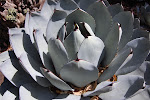Questions I get from dog owners usually start with the words "How can I get my dog to not . . . " While I leave the dog training to professionals, I can share some ideas I've found that allow me to have some peace with my dogs in my yard. The best tip I have for being able to enjoy both your dog and your garden together is to observe your dog's natural behavior and then incorporate it (not fight it!) into your plans for your yard.
For instance, dogs are natural trail makers; that is, they follow the same paths around your yard as they go about patrolling their territory. One place most dog owners fret about dog trails is along fences, especially if there are other dogs beyond the boundary. Any plant along the fence gets trampled and the traffic will leave a muddy rut that won't go away. If your yard is big enough, you can plant a hedge that shields the fence trail from view. Or, you can use large flagstone pieces or pre-cast concrete steppers for the trail along the fence. Clear the area (if your dog has not already) and lay the stones on top on the ground, or dig them in for a more finished appearance, along the entire fence line that your dog uses. The idea is to use pieces heavy enough so that your dog can't dislodge them when running over them. Smaller rocks will spew into the lawn and disappear; smaller, sharp gravel will hurt dog paws. Other things not to use: landscape fabric; pea gravel; 3/4 inch gravel; grass; or ground covers.

Also on the most-asked list is about dogs digging in the garden. My experience with this includes two dogs digging up, over time, about an acre looking for who knows what, leaving a landscape looking like it had been mined. And, one dog digging up six raised beds in a vegetable garden one July evening while I was in town (see culprit at left). I can't say that I met these actions with a peaceful, accepting demeanor but I did learn what to do the next time. In my present yard, I fence the vegetable garden with lightweight, movable fencing from the time I start to clean up the patch for planting. Because, what dog can resist the soft, moist dirt of a new garden? Ever? For the rest of the yard, I think my dogs were mainly looking for a place to cool off, so I gave them one. Mo Gilmer calls these summer flop spots which I think is the perfect description. I chose a place along the shady east side of my house under the eaves; wait, my dog Patsy Cline chose it, really, I just followed her lead. I dug out a shallow pit and filled the bottom with sand, Gilmer's tip so the spot doesn't become muddy. Then I keep the area moist with a daily mist from the hose or edge spray from the sprinkler. Patsy hangs out there most of the day now, digging around in it to get at the cooler soil deep down.
And the most asked question about dogs and yards? How to stop/deal with/prevent/protect from urine spots in the grass? Quick answer: you can't. There're lots of urban legends out there but it's the nitrogen concentration in the urine that causes the problem. The spots are most noticeable in highly fertilized lawns so back off or eliminate the lawn fertilizer. That would benefit your dog's health, too.
Those dogs in the photos? My teachers, Pecos Bill, top; and Patsy Cline, below. Photos by Gina Burkhardt.







